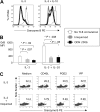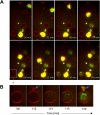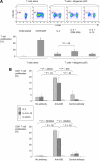Granzyme B produced by human plasmacytoid dendritic cells suppresses T-cell expansion
- PMID: 19965634
- PMCID: PMC2920226
- DOI: 10.1182/blood-2009-07-235382
Granzyme B produced by human plasmacytoid dendritic cells suppresses T-cell expansion
Abstract
Human plasmacytoid dendritic cells (pDCs) are crucially involved in the modulation of adaptive T-cell responses in the course of neoplastic, viral, and autoimmune disorders. In several of these diseases elevated extracellular levels of the serine protease granzyme B (GrB) are observed. Here we demonstrate that human pDCs can be an abundant source of GrB and that such GrB(+) pDCs potently suppress T-cell proliferation in a GrB-dependent, perforin-independent manner, a process reminiscent of regulatory T cells. Moreover, we show that GrB expression is strictly regulated on a transcriptional level involving Janus kinase 1 (JAK1), signal transducer and activator of transcription 3 (STAT3), and STAT5 and that interleukin-3 (IL-3), a cytokine secreted by activated T cells, plays a central role for GrB induction. Moreover, we find that the immunosuppressive cytokine IL-10 enhances, while Toll-like receptor agonists and CD40 ligand strongly inhibit, GrB secretion by pDCs. GrB-secreting pDCs may play a regulatory role for immune evasion of tumors, antiviral immune responses, and autoimmune processes. Our results provide novel information about the complex network of pDC-T-cell interactions and may contribute to an improvement of prophylactic and therapeutic vaccinations.
Figures







Similar articles
-
Functional expression of granzyme B in human plasmacytoid dendritic cells: a role in allergic inflammation.Clin Exp Allergy. 2010 Jul;40(7):1015-24. doi: 10.1111/j.1365-2222.2010.03499.x. Epub 2010 Apr 13. Clin Exp Allergy. 2010. PMID: 20412137
-
IL-21-stimulated human plasmacytoid dendritic cells secrete granzyme B, which impairs their capacity to induce T-cell proliferation.Blood. 2013 Apr 18;121(16):3103-11. doi: 10.1182/blood-2012-08-452995. Epub 2013 Feb 13. Blood. 2013. PMID: 23407551 Free PMC article.
-
Antiviral vaccines license T cell responses by suppressing granzyme B levels in human plasmacytoid dendritic cells.J Immunol. 2013 Aug 1;191(3):1144-53. doi: 10.4049/jimmunol.1203479. Epub 2013 Jun 19. J Immunol. 2013. PMID: 23785122
-
Approaches to the pharmacological modulation of plasmacytoid dendritic cells.Endocr Metab Immune Disord Drug Targets. 2011 Jun;11(2):154-64. doi: 10.2174/187153011795564205. Endocr Metab Immune Disord Drug Targets. 2011. PMID: 21476966 Review.
-
Intracellular versus extracellular granzyme B in immunity and disease: challenging the dogma.Lab Invest. 2009 Nov;89(11):1195-220. doi: 10.1038/labinvest.2009.91. Epub 2009 Sep 21. Lab Invest. 2009. PMID: 19770840 Free PMC article. Review.
Cited by
-
Why do human B cells secrete granzyme B? Insights into a novel B-cell differentiation pathway.Oncoimmunology. 2012 Nov 1;1(8):1368-1375. doi: 10.4161/onci.22354. Oncoimmunology. 2012. PMID: 23243600 Free PMC article.
-
Plasmacytoid dendritic cells at the forefront of anti-cancer immunity: rewiring strategies for tumor microenvironment remodeling.J Exp Clin Cancer Res. 2024 Jul 17;43(1):196. doi: 10.1186/s13046-024-03121-9. J Exp Clin Cancer Res. 2024. PMID: 39020402 Free PMC article. Review.
-
Clinical Significance of Tumor-Infiltrating Conventional and Plasmacytoid Dendritic Cells in Pancreatic Ductal Adenocarcinoma.Cancers (Basel). 2022 Feb 26;14(5):1216. doi: 10.3390/cancers14051216. Cancers (Basel). 2022. PMID: 35267524 Free PMC article.
-
Imiquimod inhibits melanoma development by promoting pDC cytotoxic functions and impeding tumor vascularization.J Invest Dermatol. 2014 Oct;134(10):2551-2561. doi: 10.1038/jid.2014.194. Epub 2014 Apr 21. J Invest Dermatol. 2014. PMID: 24751730
-
Functional Role of Dendritic Cell Subsets in Cancer Progression and Clinical Implications.Int J Mol Sci. 2020 May 30;21(11):3930. doi: 10.3390/ijms21113930. Int J Mol Sci. 2020. PMID: 32486257 Free PMC article. Review.
References
-
- Gilliet M, Cao W, Liu YJ. Plasmacytoid dendritic cells: sensing nucleic acids in viral infection and autoimmune diseases. Nat Rev Immunol. 2008;8(8):594–606. - PubMed
-
- Colonna M, Trinchieri G, Liu YJ. Plasmacytoid dendritic cells in immunity. Nat Immunol. 2004;5(12):1219–1226. - PubMed
-
- Waldner H. The role of innate immune responses in autoimmune disease development. Autoimmun Rev. 2009;8(5):400–404. - PubMed
-
- Liu YJ. IPC: professional type 1 interferon-producing cells and plasmacytoid dendritic cell precursors. Annu Rev Immunol. 2005;23:275–306. - PubMed
Publication types
MeSH terms
Substances
Grants and funding
LinkOut - more resources
Full Text Sources
Medical
Research Materials
Miscellaneous

